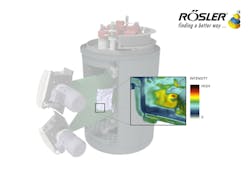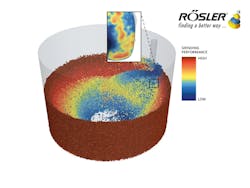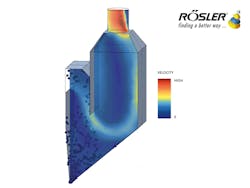Simulating Shot Blasting Machines and Processes
In many industries shot blasting is an indispensable surface treatment technology. Apart from the goal of achieving the best possible results, customers always demand short cycle times, the lowest possible costs, and minimal material input.
Rösler fulfills these requirements, among other things, by using ultra-modern simulation software. In addition, virtual models significantly reduce the time for engineering—especially for large, complex machinery—and ensure that the equipment is available within shorter lead times.
Shot blasting is an excellent tool for surface cleaning, deburring, surface preparation for painting or coating, and shot peening. As such the shot blasting technology is used for creating optimal surface finishes, be it to ensure problem-free downstream manufacturing operations or to optimize the functional characteristics of a product. With shot blasting and any other industrial processes, the customers face the challenge of improving productivity and cost-efficiency as well as minimizing the use of valuable resources. Rösler supports its customers with state-of-the-art simulation software during the planning phase for new shot blast equipment, especially with regard to process development and optimization.
Achieving Optimal Results With High Cost-Efficiency
With the Rösler simulation software every physical stage of the shot blasting process, including the respective workpieces, can be displayed in a 3D model. This includes the blast media type, the thrown media quantity, and the media flow. The data generated by the so-called particle simulation allow a precise evaluation of how much blast media is required, and with which impact energy it must hit different workpiece surface areas to achieve 100% coverage.
At the same time, the data help determine the required turbine power, the ideal position of the turbines, and the design of suitable workpiece fixtures. The simulations facilitate the development of shot blast machinery and processes for achieving optimal shot blast results with the lowest possible number of turbines, low energy input, and minimal machine wear. They also help reduce capital expenditures, operating costs, and the use of valuable resources.
Another benefit of simulations is that shot blast machinery for new workpieces can be planned on the basis of CAD data, well before the actual workpieces are available in prototype form. This saves precious time because a shot blast machine can start productive operation on the same date it is commissioned. Time-consuming and costly processing trials with actual workpieces are more or less eliminated.
Moreover, the simulations also provide valuable insights as to whether the specified blast results can be achieved on workpieces with a given geometry. Should this not be possible, the simulation results provide valuable pointers regarding the optimization of the workpiece shape.
Shorter Planning Phase and Optimal Results for Complex Projects
Planning and commissioning big, complex shot blast machines for treating components with large dimensions, for example, 66 x 16 x 13 feet (20 x 5 x 4 meters) (L x W x H) is particularly challenging.
Usually, for such large workpieces, practically no machines are available for running processing trials. In such cases, simulation and virtual planning of the shot blasting processes may be the only tools available for achieving excellent blasting results and high equipment efficiency.
For exactly this purpose Rösler developed another software module that models large, complex equipment and the respective shot blast processes. On the one hand, the realistic and correct depiction of the blast patterns and the underlying media flow substantially reduces the overall investment risk. On the other hand, the time requirements for planning and commissioning of a shot blast machine can be significantly shortened.
Faster Processing of Workpiece Batches
When it comes to shot blasting entire batches of relatively small work pieces, for example in multi-tumbler blast machines (RMT), the optimal mixing of workpieces and blast media can significantly influence the processing results and cycle times. For such applications, the software allows the simulation and optimization of the tumbling action of the workpieces in the drum-shaped blast chamber. This will result in the shortest possible process times. In some cases, cycle time reductions of around 25 % per batch could be achieved resulting in a considerable capacity increase.
Energy-saving and Effective Dust Collectors
In shot blast machines the turbines and dust collectors require by far the highest energy input. This applies to standard as well as large shot blast machines. Therefore, the software package also includes a special airflow simulation module that determines the air volume required to safely evacuate the dust generated during the blast operation from the blast chamber. If the dust can be evacuated more effectively by an improved airflow, it is possible that a smaller dust collector can be utilized resulting in a lower energy consumption. In any case, an optimized air evacuation system helps reduce cycle times and, therefore, increases productivity. Furthermore, the workpieces are leaving the shot blast machine cleaner, thus facilitating downstream manufacturing operations.
Digital Twins of Blast Turbines Increase Efficiency
To reduce their energy consumption and wear rate and, at the same time, increase their operational efficiency, Rösler works with digital twins of the blast turbines. The replication of the particle flow provides a virtual analysis of the wear areas in a turbine. This, in turn, allows the implementation of geometrical turbine modifications to minimize the wear rate. Other simulations can be conducted to increase the turbine efficiency, which, in turn, will result in additional energy savings.
Thanks to the broad application of simulation software for the design of shot blast equipment and the respective processes, as well as for the optimization of the airflow and turbine technology, the lead times for Rösler shot blast machines are substantially shortened. Moreover, they produce substantial energy savings and a lower wear rate. All this results in significant customer benefits.
Simulation systems for mass-finishing processes dealing with complex workpieces To date the development of mass-finishing processes for single-piece processing of geometrically complex and difficult-to-machine workpieces, such as knee implants, required numerous processing trials. For such elaborate applications, usually handled in so-called drag finishers, Rösler is also using simulation technologies.
For questions regarding the simulation of shot blasting and mass finishing operations, contact Mr. Tom Kollacks at 0 9533 924 491 or email [email protected].
For over 80 years, the privately owned Rösler Oberflächentechnik GmbH has been actively engaged in the field of surface preparation and surface finishing. Rösler offers a comprehensive portfolio of equipment, consumables, and services around the mass finishing and shot blasting technologies for a wide spectrum of different industries. Under the brand name AM Solutions, Rösler offers numerous equipment solutions and services in the area of additive manufacturing/3D printing. For more information, visit www.rosler.com



